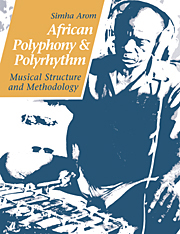Book contents
- Frontmatter
- Contents
- List of illustrations
- Foreword by György Ligeti
- Preface
- Acknowledgements
- BOOK I THE MUSIC OF THE CENTRAL AFRICAN REPUBLIC
- BOOK II AFRICAN POLYPHONIC MUSIC
- BOOK III TECHNICAL TOOLS: METHODS OF RECORDING POLYPHONIC MUSIC FOR TRANSCRIPTION
- BOOK IV THEORETICAL TOOLS
- 1 The notion of relevance
- 2 Description and analysis
- 3 The question of transcription
- BOOK V THE ORGANISATION OF TIME IN AFRICAN MUSIC
- BOOK VI STRUCTURAL PRINCIPLES AND THEIR APPLICATION
- Conclusion
- Bibliography
3 - The question of transcription
Published online by Cambridge University Press: 27 January 2010
- Frontmatter
- Contents
- List of illustrations
- Foreword by György Ligeti
- Preface
- Acknowledgements
- BOOK I THE MUSIC OF THE CENTRAL AFRICAN REPUBLIC
- BOOK II AFRICAN POLYPHONIC MUSIC
- BOOK III TECHNICAL TOOLS: METHODS OF RECORDING POLYPHONIC MUSIC FOR TRANSCRIPTION
- BOOK IV THEORETICAL TOOLS
- 1 The notion of relevance
- 2 Description and analysis
- 3 The question of transcription
- BOOK V THE ORGANISATION OF TIME IN AFRICAN MUSIC
- BOOK VI STRUCTURAL PRINCIPLES AND THEIR APPLICATION
- Conclusion
- Bibliography
Summary
THE LIMITS OF WRITTEN NOTATION
The need for transcriptions in the analysis of Central African polyphony has already been made abundantly clear. This should not, however, obscure the many limitations inherent in the notation of orally transmitted music. In fact, we here encounter the infinitely wider problem of reducing any oral expression whatsoever to a written form of symbolisation. ‘Writing veils language; it disguises rather than clothes it’ (Saussure 1916, 1971: 51–2).
Senghor extols the virtues of the oral transmission of culture in Africa: ‘Black Africa has had the good fortune to ignore writing, even when it was not unaware of its existence … For writing impoverishes reality. It crystallises it into fixed categories and freezes it, when reality is properly alive, fluid, and shapeless’ (1958, 1964: 238–9).
Whether it be language or music, writing is responsible for immobilising reality in a univocal way. Chailley (1967: 118) also stresses the limits to notation, and defines the role of the ‘written sign’ in music as follows:
Until very recently, it was never expected to represent every detail of music. It was only intended to transmit a fleshless but indispensable skeleton of ‘note music’. The recipients were then to make use of their own sensitivity and intelligence to bring it alive again according to their own lights. This is why, from generation to generation, music has always remained a living being, despite being on Paper. The ‘written’ skeleton has been filled out with one kind of flesh after another, as Man passes on to men the only message in music that counts: the one that sets the limit beyond which machines, even the most wonderful of machines, can no longer rule.
- Type
- Chapter
- Information
- African Polyphony and PolyrhythmMusical Structure and Methodology, pp. 169 - 176Publisher: Cambridge University PressPrint publication year: 1991



